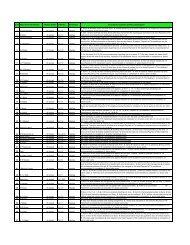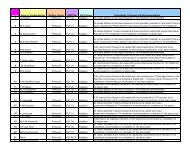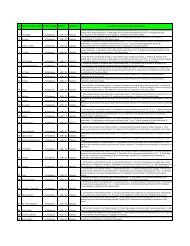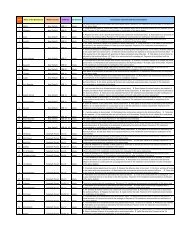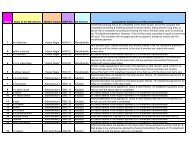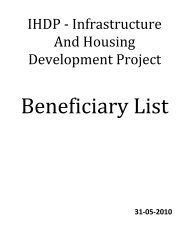Project Appraisal Document - IHDP
Project Appraisal Document - IHDP
Project Appraisal Document - IHDP
- No tags were found...
Create successful ePaper yourself
Turn your PDF publications into a flip-book with our unique Google optimized e-Paper software.
SRI LANKA: PUTTALAM HOUSING PROJECTAnnex 1: Background and <strong>Project</strong> Design FrameworkBackgroundThe District of Puttalam in north west Sri Lanka is now home to many refugees displaced fromthe North in 1990. According to the UNHCR supervised census of IDPs in Puttalam conducted inApril 2006, 63,145 persons or 15,480 families lived in 141 refugee camps. 41% of the PuttalamIDPs were children under the age of 18. 72% of the IDPs originate from Mannar; 14% come fromJaffna and 10% from Mullaitivu. The rest come from other districts in the North. The SocialAssessment carried out as part of project preparation indicated that 62% of the adult populationworked as seasonal day labor in the informal sector. About 18% of those surveyed in the UNHCRexercise reported that they had no schooling while 23% had a primary school education alone.Just 8% had completed their high school education. The IDPs are located in four divisions in thePuttalam district: Kalpitiya (55%), Puttalam (33%), Mundel (8%) and Vanathavillu (3%). 96% ofPuttalam IDPs (14,928 families) indicated that they wished to remain and integrate in Puttalam,citing security concerns as the major obstacle to return to their original homes 21 . 74% of the IDPhouseholds had in fact bought land in Puttalam demonstrating a resolve to remain there.Most refugee camps lack basic services including access to safe drinking water, toilet facilities,proper drainage and garbage disposal. The UNHCR survey indicated that only 40% of the IDPpopulation had private permanent toilets. Since the provision of basic services and ancillaryinfrastructure is key to the sustainability of permanent housing, the PHP is designed within acomprehensive settlement planning framework.Housing Conditions of IDPs: The UNHCR survey indicated that 12% of houses in the refugeecamps were permanent, 25% were partly-completed and 63% were temporary houses 22 . Of the12,154 families who require adequate housing, 6,501 live with near-relatives as dependentfamilies, 5653 families live in temporary thatched huts and 2,232 families live in partlycompletedhouses.Water and Sanitation: Puttalam has a dry climate with an annual rainfall of about 15 to 30 cms.Even though, the ground-water located in coastal aquifers and underlying Miocene limestonelocated in parts of Kalpitiya could meet the needs of the Kalpitiya peninsula residents, thecontamination of the ground-water from agricultural run-off, inappropriately designed excretadisposal in areas with a high water table, improper siting of toilets and inadequate maintenancecompromise water quality. The excessive extraction of ground-water and the consequent intrusionof sea water further contaminate the water. The demand for water from the growing populationand physical distance between water sources and the camps add to the scarcity of drinking water.The UNHCR survey revealed that 28% of the population had access to a private well or pipedsupply, while 19% had no direct access to water. The local authority provides water to refugeecamps close to Puttalam town by browsers. The situation in the Mundel and Vanathavilludivisions are not better. The main sources of water in all divisions are dug wells and hand pumps.21 UNHCR supervised survey. Most of the Puttalam IDPs are Muslim and were expelled from the North bythe LTTE in October 1990. Depending on their place of origin, they were compelled to leave their homeswithin 2 hours, 48 hours or one week. Their lack of desire to return compares starkly with the overallnumbers of returnees to the North East until the recent deterioration of the security environment.22 Permanent houses (with completed structure and finishing), semi-permanent houses (partly constructedbut need home improvements), and temporary houses (thatched houses with poor living condition).21



